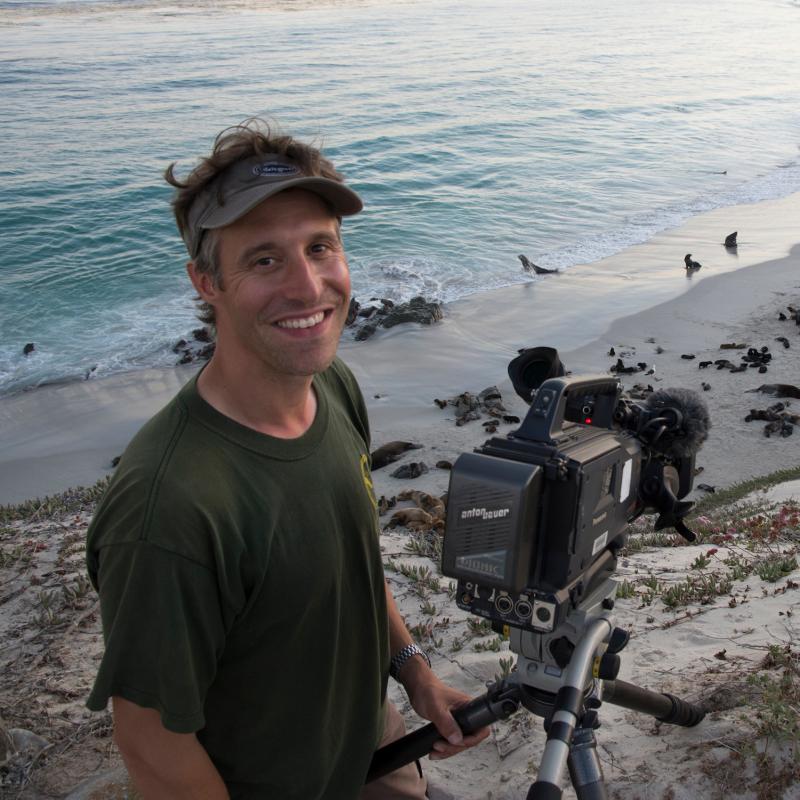Why Survey with Stereo Cameras?
These seamount surveys are being conducted with a stereo drop-camera system that hangs directly below the vessel. You can learn a lot about the specifications of the rig from a previous blog that covered the Gulf of Alaska survey earlier this summer or the Deep-Sea Corals and Sponges of Alaska Story Map. The take-home is that stereo cameras (two cameras separated by a set distance and shooting photos at precisely the same time) allow the scientists to see a three-dimensional view of what’s in front of the rig. From that pair of images, they can determine distance and size—much like your eyes.
With precisely spaced and calibrated cameras, AFSC scientists have developed cutting-edge software that can provide measurements of anything that’s seen in both frames. This is pretty incredible. Without being down there, we can figure out how big a fish is, or a crab, and how tall a coral is, or how wide the opening is at the top of a sponge.
And the reason that we need a system like the drop camera is that traditional trawl surveys can’t effectively survey the high-relief, rocky substrate that you find in places like seamounts. In traditional trawl surveys, we tow a net over an area to capture the things living there. The scientists also record what’s brought up on deck. It’s a very effective and efficient method, but the nets can get hung up on uneven bottoms. And they can’t reach into crevices and cracks where you’d find many rockfish…because, uh, rockfish like to hang out in and among the rocks!
More Sampling = Better Models
So, dropping a camera down to the bottom allows us to get a non-invasive look at what’s living there—with pretty incredible precision. And the end product coming out of the data that we collect here will build on existing models of coral and sponge distribution so they are more accurate. Current models are based on very limited data and can only do so much.
But what the drop-camera method can’t do is cover a ton of ground quickly like a trawl survey can, or collect biological samples, which is important for other research. So, with the drop-cameras, we sample as many sites as possible with the time we have on the ship.
The drop-camera crew works 12-hour shifts from 7am to 7pm, and the goal of this expedition is to do 15-minute surveys at 95 sites on these five seamounts. We need lots of sites at multiple locations and varying depths to make the models more robust. Sites are split across different depths down to 1,100 meters (over 3,500 feet, or 2/3rds of a mile), and the number of sites per seamount depends on the area and depth of that seamount. A wider seamount that reaches shallower depths is sampled more than a smaller seamount that’s deeper. Here’s a table that spells this out:
The Cool Critters of Corn Seamount
As you can see, the Warwick and Eickelberg sites featured in Blog #1 were some of the deepest sites, and Corn has more sites in the 400-600 meter range. As far as fish, we only saw thornyhead rockfish during our first couple days. However, we saw more diversity on Corn Seamount, including blackspotted rockfish, which is one of the deeper-living rockfish species.
Dr. Christina Conrath is a fisheries biologist for the Alaska Fisheries Science Center working on this survey. She’s based in Kodiak and spends much of her time working the deck of trawl surveys. She’s used to seeing these fish brought up in the nets, and really enjoys watching the live video feed to the onboard lab. She remarks that it’s really cool to see the fish in their natural habitat, hiding under and between rocks, and in cracks. She continues by saying that this survey method is super important to complement the trawl surveys, which would miss the rockfish that are tucked out of reach of a trawl net. In addition to surveying coral and sponge, the data we collect may also justify this method as a way to assess our fish populations and stocks. Better stock assessments lead to better fisheries management.
Finally, this survey of Corn Seamount is intriguing because we’ve never visually surveyed this seamount before. It will be exciting for the team to analyze all the data and publish the significant findings. In the meantime, enjoy these snapshots of the cool scenes and critters we came across. And tune into Blog 4 to see what we find at Cobb Seamount, and about how these seamounts formed from the “Cobb Hotspot.”




















